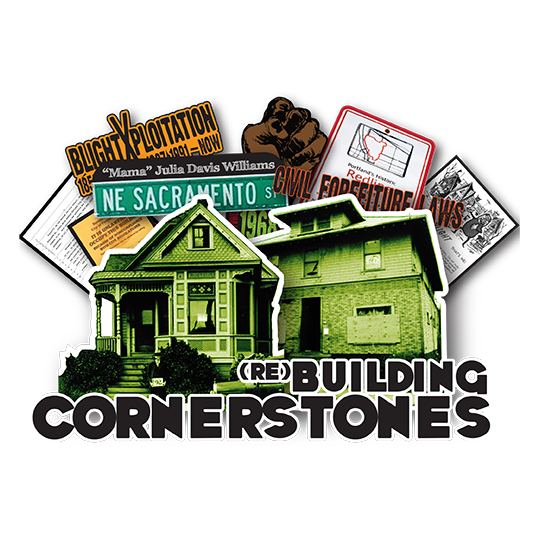ARTchive History
ARTchives Could Be A Game Changer for Documenting Portland’s Black Diaspora
Bruce Poinsette for Eliot News, January 2019
Portland’s history (and present) is riddled with stories of housing discrimination. However, when we discuss the history of clearing out predominantly Black neighborhoods to make way for things like the I5 Freeway, Memorial Coliseum, and Emanuel Hospital, or the systemic practice of redlining, it’s often through the prism of broader narratives and statistics. As a result, many of the individual stories get lost.
“It will be an extraction and extension of the narrative story and artwork of the oppressed, exploited, and innovative history of Blacks in Portland,” says Davis.
The idea for the ARTchives originated from Davis’s research into Portland’s forfeiture laws, which he is doing as part of an artist residency with the Portland Archives. Beyond simply telling stories and creating beautiful visuals, he emphasizes that the goal of his art is to create real impact and change. In many ways, the ARTchives is just the latest evolution of his years of public art projects, which includes the recent, highly acclaimed Historic Black Williams Project, a collaboration with wife Kayin Talton-Davis that details the history of Williams Ave.
Creating the ARTchives at his grandmother’s property on NE Sacramento St. that was purchased in the 1980s during the height of the city’s use of property forfeiture, is personal for Davis. “Mama” Julia Davis had purchased the property as a source of income: there was a seven-unit apartment building undergoing renovation in the front of the lot, and a small house in the back which was rented out as well. Davis believes that his grandmother’s property was targeted because her purchase of the property in 1982 reset the date for which the City could demolish and ultimately take control of the land. Though the family worked to finish the renovations started by the previous owners, the city required a $50,000 bond to continue work, which the family could not meet. The renovation work turned to salvage, and when the demolition permit ran out, the city showed up with bulldozers, a bill, and a lien against the property. An appeal led only to keeping the small rental house in the back, which the city tried to condemn the based on charges that drugs were allegedly being sold there. While these charges were ultimately dismissed, the situation still matched a larger narrative during the 80s and 90s where Black residents of NE Portland were harassed by representatives of the City and other white-owned interests to sell their homes. This included charges of not just drug and gang activity, but also the targeting of Black-owned homes for supposedly having “blight.” According to a 1962 official document from the Portland Bureau of Buildings, blight could include roof leaks, loose steps, doors that “stick,” uncovered trash, and even vaguely worded charges such as “needs paint” and “needs clean up.”
Through a public art display, Davis hopes to illustrate the process in which predominantly Black-owned homes were targeted using the levers of local government and seemingly colorblind campaigns against “blight.” By converting the space into an archive that doesn’t just capture the history of Blacks who lived in the area, but of all the Black people who have also stopped through and/or made contributions to the community, Davis hopes to encourage others to do their own research.
“It would be that social presence with archivable material, as well as a place to do research and art from that material,” says Davis. “We want to have this as an extension of all the other archivable resources already located in Oregon, not just Portland.”
